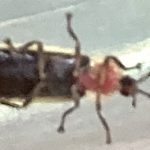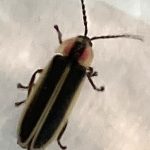Notice: Below is a list of 0 important links included on this page.
Please note that while screen readers have made significant strides, they may still lack full support for optimal web accessibility.



You must be logged in to post a comment.
This is a project of the Xerces Society, working in collaboration with the IUCN SSC Firefly Specialist Group and New Mexico BioPark Society.
Copyright © 2025 The Xerces Society •1631 NE Broadway Street, #821 • Portland OR 97232 USA
Thank you for submitting this firefly observation! The firefly that you photographed is a female firefly in the genus Photinus, but it does not appear to be the big dipper (Photinus pyralis). The black marking on the head shield (pronotum) is a rectangular bar extending the length of the pronotum, while in Photinus pyralis it is usually a central oval spot.
While the flash pattern described is not a match for the double-flashing species, I think that this firefly is in the Photinus consanguineus group: Photinus jamesi, Photinus macdermotti, Photinus consanguineus or Photinus ignitus. Of these, Photinus ignitus is the best match in terms of male flash pattern.
This is a neat observation, as there aren’t many records of flashing Photinus fireflies on Long Island that are not Photinus pyralis!